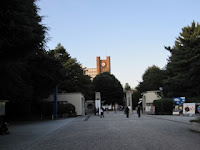

There are universities, research institutes and cultural facilities in Komaba, a few kilometers from Shibuya.
The Meiji government established the nation’s first public school for elite students in 1886. Then, Komaba has become one of Tokyo's cultural centers. The school turned into a part of the University of Tokyo after the World War 2.
The campus is mainly used for the education of freshmen and sophomores of the university now. Ginkgo trees make lines along the streets in the campus. The tree is used in the logo of the university.
The Meiji government established the nation’s first public school for elite students in 1886. Then, Komaba has become one of Tokyo's cultural centers. The school turned into a part of the University of Tokyo after the World War 2.
The campus is mainly used for the education of freshmen and sophomores of the university now. Ginkgo trees make lines along the streets in the campus. The tree is used in the logo of the university.
It was a ginkgo nut season. It smelled.
 Komabano Park has been developed in the site of former Tokyo University of Education. Modern agriculture (on western technologies) started here in the Meiji era. They still have a small rice field in the park.
Komabano Park has been developed in the site of former Tokyo University of Education. Modern agriculture (on western technologies) started here in the Meiji era. They still have a small rice field in the park. It was just before the harvest season and I saw the flock of sparrows eating the rice. Scarecrows did not work.
 University of Tokyo also have the Research Center for Advanced Science and Technology. Scientists study most-advanced researches in huge modern buildings. There are many foreign students and researchers working here, too. The bording houses for foreigners are also in the site.
University of Tokyo also have the Research Center for Advanced Science and Technology. Scientists study most-advanced researches in huge modern buildings. There are many foreign students and researchers working here, too. The bording houses for foreigners are also in the site. Komaba (not Komabano) Park is developed in the former private house of Marquess Maeda. Both western and Japanese houses remain.
There are two important museums near the park: The Museum of Modern Japanese Literature and Folk Craft Museum (Mingeikan).





No comments:
Post a Comment